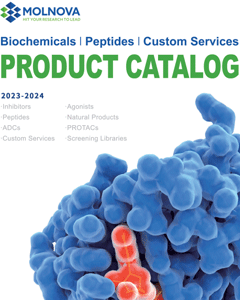
NSC 31150
CAS No. 51244-45-2
NSC 31150( —— )
Catalog No. M33810 CAS No. 51244-45-2
NSC 31150 is a potential PPAR agonist with antibacterial, antidiabetic and antioxidant activities and may be used to study cancer and bacterial infections.
Purity : >98% (HPLC)
 COA
COA
 Datasheet
Datasheet
 HNMR
HNMR
 HPLC
HPLC
 MSDS
MSDS
 Handing Instructions
Handing Instructions
| Size | Price / USD | Stock | Quantity |
| 2MG | 445 | Get Quote |


|
| 5MG | 686 | Get Quote |


|
| 10MG | 938 | Get Quote |


|
| 25MG | 1398 | Get Quote |


|
| 50MG | 1822 | Get Quote |


|
| 500MG | Get Quote | Get Quote |


|
| 1G | Get Quote | Get Quote |


|
Biological Information
-
Product NameNSC 31150
-
NoteResearch use only, not for human use.
-
Brief DescriptionNSC 31150 is a potential PPAR agonist with antibacterial, antidiabetic and antioxidant activities and may be used to study cancer and bacterial infections.
-
DescriptionNSC 31150 is a potential PPAR agonist with antibacterial, antidiabetic and antioxidant activities and may be used to study cancer and bacterial infections.
-
In Vitro——
-
In Vivo——
-
Synonyms——
-
PathwayOthers
-
TargetAntioxidant
-
RecptorAntioxidant | PPAR | Antibiotic
-
Research Area——
-
Indication——
Chemical Information
-
CAS Number51244-45-2
-
Formula Weight274.12
-
Molecular FormulaC10H5Cl2NO2S
-
Purity>98% (HPLC)
-
Solubility——
-
SMILESO=C1SC(=CC2=CC=C(Cl)C=C2Cl)C(=O)N1
-
Chemical Name——
Shipping & Storage Information
-
Storage(-20℃)
-
ShippingWith Ice Pack
-
Stability≥ 2 years
Reference
molnova catalog



related products
-
Oleoylestrone
Oleoylestrone (MP-101) is present in plasma and adipose tissue, has potential antioxidant effects, induces loss of body fat in rats, and can be used for weight loss.
-
mogroside Ive
Mogroside IV-E is a triterpenoid glycoside isolated from the extracts of Luo Han Guo. Mogrosides exhibit antidiabetic antioxidant and anticancer activities.
-
Methyl-β-cyclodextri...
Methyl-β-cyclodextrin, a cyclic heptasaccharide, is an effective agent for the depletion of cholesterol from cells; also inhibits PEL cell growth with an IC50 of 3.33-4.23 mM.



 Cart
Cart
 sales@molnova.com
sales@molnova.com


